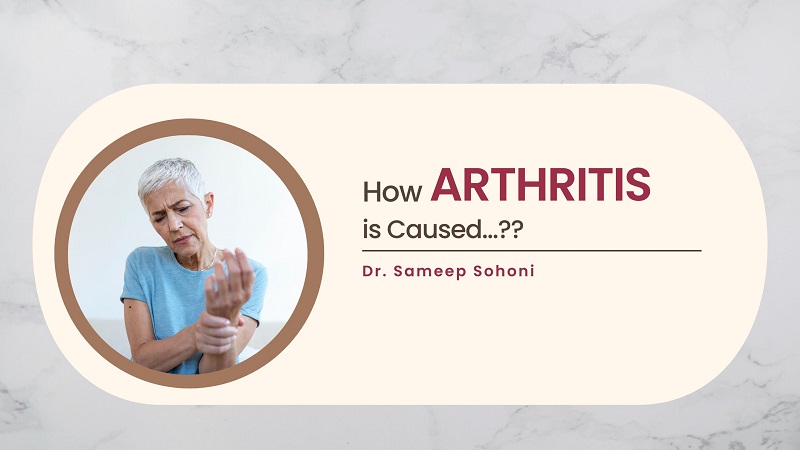How Arthritis is Caused? How Many Types of Arthritis Are There?

Arthritis, a common joint disorder that causes pain and stiffness, is like a puzzle with many elements that are influenced by factors such as our DNA (genetic issue), immune system function, natural cartilage breakdown with age, infections, and even diet. Let’s take a comprehensive look at how arthritis is caused, its various types, and how we can treat or prevent it.
What are the 7 Types of Arthritis?
Have you any idea how many types of arthritis are there? There are over 100 types of arthritis. However, the 7 most common types of arthritis:
Type of Arthritis |
What Is It |
Examples |
|
Inflammatory Arthritis |
Causes joint pain, stiffness, and swelling due to unknown inflammation. |
RA, reactive arthritis, ankylosing spondylitis, psoriatic arthritis |
|
Degenerative/Mechanical Arthritis |
Involves cartilage damage resulting in joint friction and bone structure changes. |
Osteoarthritis |
|
Connective Tissue Disease |
Joint and other tissue inflammation, including skin, muscles, lungs, and kidneys. |
SLE, scleroderma, dermatomyositis, Sjogren’s |
|
Infectious Arthritis |
Invasion (attack) of bacteria, viruses, or fungi into the joint causes inflammation. |
Salmonella, chlamydia, hepatitis C |
|
Metabolic Arthritis |
An accumulation of uric acid crystallizes in the joints, causing sudden joint pain (gout). |
Gout |
|
Childhood Arthritis |
Several types of arthritis affect children, potentially causing joint damage. Potential for remission. |
Juvenile idiopathic arthritis (JIA) |
|
Septic Arthritis |
Inflammation of the joints due to a bacterial or fungal infection, which may result in increased joint degeneration. |
Acute septic arthritis, chronic septic arthritis |
How is Arthritis Caused?
Arthritis, from the Greek words “arthro” (joint) and “itis” (inflammation), refers to inflammatory joint disorders that cause pain, stiffness, and joint dysfunction. Disruptions of the delicate balance between pro-inflammatory and anti-inflammatory mediators trigger many causes. These disruptions are possibly the result of immunological dysregulation, genetics, and the environment.
Inflammatory arthritis, such as rheumatoid arthritis (RA), triggers an autoimmune reaction in which T-cells mistakenly attack the synovial membrane. Cytokines like tumor necrosis factor-alpha (TNF-) and interleukin-6 (IL-6) plays an inflammatory symphony that causes synovial hypertrophy, pannus formation, and joint degradation.
Osteoarthritis (OA), on the other hand, results from the progressive deterioration of articular cartilage, which causes biomechanical imbalances. As cartilage breaks down, the joint’s natural healing systems suffer. Chondrocytes, the cells that produce cartilage, exhibit diminished anabolic activity and increased catabolism, exacerbating the disruptive environment. OA is a complex condition that results from factors like mechanical stress, joint weakness, and getting older.
Emerging evidence highlights the complex relationship between dietary choices and arthritis severity. Arthritis causes food rich in purines—uric acid precursors—to cause gout, acute inflammatory arthritis. Also, excessive consumption of saturated fats, which are found in red meat and processed foods, stimulates the trigger of inflammation, worsening conditions such as RA.
Arthritis Treatment
Treatment for arthritis varies depending on its type, severity & how arthritis is caused. Treatments for arthritis include pharmacological and non-pharmacological methods.
- The primary therapy, non-steroidal anti-inflammatory medications (NSAIDs), targets the COX enzyme pathway to reduce inflammation and pain.
- DMARDs like methotrexate slow RA development by interfering with the immune system.
- Biologic drugs, an advance in arthritis treatment, inhibit cytokines including TNF- and IL-6. Agents from the monoclonal antibody and fusion protein families operate as sentinels, preventing uncontrolled inflammation.
- The emerging field of precision medicine tailors therapy to genetic profiles for maximum effectiveness and minimum side effects.
How to Prevent Arthritis?
Although there is currently no cure for arthritis, there are steps you can take to lessen your chances of developing the disease.
- Lifestyle modifications, such as maintaining a healthy weight, exercising regularly, eating a healthy diet, avoiding injuries to the joints, and quitting unhealthy habits of smoking or drinking to avoid arthritis,
Some preventive measures in the management of arthritic symptoms:
- Following doctor-prescribed anti-inflammatory medications that can aid in the control of inflammation and discomfort in mild to severe cases of arthritis
- Recommended physical therapy to enhance joint range of motion, joint strength, and joint flexibility
Conclusion
Arthritis is a chronic disorder. Addressing the root causes and taking a comprehensive treatment or preventive approach to joint health may reduce arthritis’s effects and improve quality of life.
FAQ
How is arthritis diagnosed?
Orthopedic expert Dr. Sameep Sohoni, an Orthopedic Doctor in Thane, will examine the record of the patient’s medical history to determine how arthritis is caused through a physical examination and prescribe tests such as X-rays, blood tests, and imaging scans to diagnose arthritis.
What are the symptoms of arthritis in the legs?
Depending on the type of arthritis, the symptoms of arthritis in the legs and other joints can vary, but some common symptoms include pain, stiffness, swelling, limited range of motion, weakness, crepitus (a grating or grinding sound), and deformity over time.
Dr. Sameep Sohoni: The Best Joint Replacement Doctor in Thane
Dr. Sameep Sohoni is a renowned orthopedic and knee replacement surgeon in Thane. He is well-known for his expertise in arthroscopy, joint replacement, and conservation methods. He prioritizes cutting-edge technologies and devotes to holistic patient care.
If you are concerned about how arthritis is caused & other concern factors, consult with Dr. Sameep, a joint replacement doctor in Thane. Early detection and treatment can help prevent permanent joint injuries and enhance your quality of life.
Reference
- https://www.mathewsopenaccess.com/full-text/role-of-osteoclast-regulation-in-arthritis-a-review
- https://www.medicalnewstoday.com/articles/7621#causes
- https://www.ncbi.nlm.nih.gov/pmc/articles/PMC6211121/
- https://www.ncbi.nlm.nih.gov/pmc/articles/PMC2818253/
- https://www.healthline.com/nutrition/foods-to-avoid-arthritis
- https://www.hopkinsarthritis.org/arthritis-info/rheumatoid-arthritis/ra-treatment/
- https://www.physio-pedia.com/Arthritis

 Previous Post
Previous Post Next Post
Next Post
